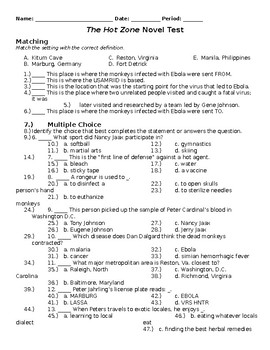

When Geisbert examines the flask with cells from the Reston monkey, he notices that the cells seem to be unrecognizably sick. Geisbert enjoys sharpening his skills by looking at viruses, such as Marburg, and is anxious to tackle a new specimen. Meanwhile, at the Institute, an intern named Tom Geisbert asks to examine the samples from the Reston facility. Unsure if he has made the correct decision in killing the animals, Dalgard stores their bodies in the facility freezer. When he dissects the animals, he is dismayed to discover that several of them appear to be perfectly healthy. However, after an initial examination of the samples, Jahrling provides Dalgard with a tentative diagnosis of simian hemorrhagic fever.ĭetermined to contain the outbreak, Dalgard euthanizes the remaining monkeys in Room F. Much to Jahrling’s chagrin, the samples arrive packaged in nothing more than tin foil. He contacts Peter Jahrling, a virologist at the Institute who specializes in monkey viruses and agrees to examine the samples. Over the course of the next several days, several monkeys from Room F die nearly every night.Īfter dissecting one of the dead monkeys, Dalgard decides to send samples of the animal’s spleen and throat mucus to USAMIRRD at Fort Detrick. Dalgard suspects that the monkeys may have died from an infectious agent such as simian hemorrhagic fever (SHF). When Dalgard returns to the facility to dissect the animals, he notices that both monkeys have enlarged spleens and blood in their intestines, but he is unable to identify a specific cause of death. When Dalgard arrives at the facility a few days later, he identifies two sick monkeys in Room F that seem to be feverish with droopy eyelids. He contacts Dan Dalgard, the consulting veterinarian for the facility, to see if he will examine and treat the monkeys. Bill Volt also notices that the heating and air-handling system in the monkey house is malfunctioning. Already 29 animals from the original shipment have died, with the majority of the deaths occurring in Room F. Less than four weeks after the shipment’s arrival, the colony manager, Bill Volt, notices that a large number of the new monkeys are dying. Two of the monkeys are dead upon arrival at the facility, but the remaining animals are placed throughout 12 holding rooms in the building.


On October 4, the facility receives a shipment of 100 wild monkeys from the Philippines.

The monkey house, officially known as the Reston Primate Quarantine Unit, is owned by Hazelton Research Products, a company that coordinates the import and sale of laboratory animals. In the second part of the book, the narrative shifts to a monkey house in Reston, Virginia in 1989.


 0 kommentar(er)
0 kommentar(er)
